What to prepare
- Google Colaboratory (*Jupyter Notebook is OK)
- Distributed source code (*not necessary if you want to do it from scratch)
What is TensorBoard?
TensorBoard provides the visualization and tools needed for machine learning.
What's inside.
- Tracking and visualization of metrics (loss, accuracy, etc.)
- Model graph visualization (operations and layers)
- Display histograms of weights, biases, and other tensors as they change over time
- Projection of embeddings into lower dimensional space
- Display of image, text, and audio data
- Profiling of TensorFlow programs
- Misc.
How to start using it quickly
Load TensorBoard.
%load_ext tensorboard
Import the required packages.
import tensorflow as tf
import datetime
MNIST dataset as an example.
Normalize the data and
write a function that creates a simple Keras model that classifies the images into 10 classes.
mnist = tf.keras.datasets.mnist
(x_train, y_train),(x_test, y_test) = mnist.load_data()
x_train, x_test = x_train / 255.0, x_test / 255.0
def create_model():
return tf.keras.models.Sequential([
tf.keras.layers.Flatten(input_shape=(28, 28)),
tf.keras.layers.Dense(512, activation='relu'),
tf.keras.layers.Dropout(0.2),
tf.keras.layers.Dense(10, activation='softmax')
])
Downloading data from https://storage.googleapis.com/tensorflow/tf-keras-datasets/mnist.npz
11493376/11490434 [==============================] - 0s 0us/step
11501568/11490434 [==============================] - 0s 0us/step
TensorBoard in Keras Model.fit().
model = create_model()
model.compile(optimizer='adam',
loss='sparse_categorical_crossentropy',
metrics=['accuracy'])
log_dir = "logs/fit/" + datetime.datetime.now().strftime("%Y%m%d-%H%M%S")
tensorboard_callback = tf.keras.callbacks.TensorBoard(log_dir=log_dir, histogram_freq=1)
model.fit(x=x_train,
y=y_train,
epochs=5,
validation_data=(x_test, y_test),
callbacks=[tensorboard_callback])
Epoch 1/5
1875/1875 [==============================] - 12s 6ms/step - loss: 0.2179 - accuracy: 0.9365 - val_loss: 0.1300 - val_accuracy: 0.9606
Epoch 2/5
1875/1875 [==============================] - 12s 6ms/step - loss: 0.0967 - accuracy: 0.9705 - val_loss: 0.0777 - val_accuracy: 0.9757
Epoch 3/5
1875/1875 [==============================] - 13s 7ms/step - loss: 0.0680 - accuracy: 0.9787 - val_loss: 0.0686 - val_accuracy: 0.9785
Epoch 4/5
1875/1875 [==============================] - 13s 7ms/step - loss: 0.0530 - accuracy: 0.9832 - val_loss: 0.0755 - val_accuracy: 0.9772
Epoch 5/5
1875/1875 [==============================] - 13s 7ms/step - loss: 0.0431 - accuracy: 0.9859 - val_loss: 0.0642 - val_accuracy: 0.9817
Start TensorflowBoard.
%tensorboard --logdir logs/fit
If you get a 403, please check your browser's
Allow Cokie
Turn off enhanced anti-tracking functionality
https://stackoverflow.com/questions/64218755/getting-error-403-in-google-colab-with-tensorboard-with-firefox
Brief description of the tabs on the top navigation bar of the dashboard
| word | meaning |
|---|---|
| Scalars | Shows loss and metric change per epoch. You can also track training speed, learning rate, and other scalar values. |
| Graphs | The model is visualized. |
| Distributions and Histograms | Shows the distribution of the tensor over time. Visualize weights and biases to help ensure that they are changing in the expected way. |
How do I use TensorBoard with other methods?
When training with methods such as tf.GradientTape(), use
Use tf.summary.
Use the same dataset as before, but use the
convert it to tf.data.Dataset and use the batch function.
train_dataset = tf.data.Dataset.from_tensor_slices((x_train, y_train))
test_dataset = tf.data.Dataset.from_tensor_slices((x_test, y_test))
train_dataset = train_dataset.shuffle(60000).batch(64)
test_dataset = test_dataset.batch(64)
Training codes should select loss and optimizer.。
loss_object = tf.keras.losses.SparseCategoricalCrossentropy()
optimizer = tf.keras.optimizers.Adam()
Create evaluation indicators that can be logged at any point in time.
train_loss = tf.keras.metrics.Mean('train_loss', dtype=tf.float32)
train_accuracy = tf.keras.metrics.SparseCategoricalAccuracy('train_accuracy')
test_loss = tf.keras.metrics.Mean('test_loss', dtype=tf.float32)
test_accuracy = tf.keras.metrics.SparseCategoricalAccuracy('test_accuracy')
Define training and testing functions.
def train_step(model, optimizer, x_train, y_train):
with tf.GradientTape() as tape:
predictions = model(x_train, training=True)
loss = loss_object(y_train, predictions)
grads = tape.gradient(loss, model.trainable_variables)
optimizer.apply_gradients(zip(grads, model.trainable_variables))
train_loss(loss)
train_accuracy(y_train, predictions)
def test_step(model, x_test, y_test):
predictions = model(x_test)
loss = loss_object(y_test, predictions)
test_loss(loss)
test_accuracy(y_test, predictions)
Prepare a process to write a summary to the logs directory.
current_time = datetime.datetime.now().strftime("%Y%m%d-%H%M%S")
train_log_dir = 'logs/gradient_tape/' + current_time + '/train'
test_log_dir = 'logs/gradient_tape/' + current_time + '/test'
train_summary_writer = tf.summary.create_file_writer(train_log_dir)
test_summary_writer = tf.summary.create_file_writer(test_log_dir)
Start training.
Use tf.summary.scalar() to write a summary and
Log losses and accuracies during training/testing.
model = create_model() # Reset model
EPOCHS = 5
for epoch in range(EPOCHS):
for (x_train, y_train) in train_dataset:
train_step(model, optimizer, x_train, y_train)
with train_summary_writer.as_default():
tf.summary.scalar('loss', train_loss.result(), step=epoch)
tf.summary.scalar('accuracy', train_accuracy.result(), step=epoch)
for (x_test, y_test) in test_dataset:
test_step(model, x_test, y_test)
with test_summary_writer.as_default():
tf.summary.scalar('loss', test_loss.result(), step=epoch)
tf.summary.scalar('accuracy', test_accuracy.result(), step=epoch)
template = 'Epoch {}, Loss: {}, Accuracy: {}, Test Loss: {}, Test Accuracy: {}'
print (template.format(epoch+1,
train_loss.result(),
train_accuracy.result()*100,
test_loss.result(),
test_accuracy.result()*100))
# Reset metrix
train_loss.reset_states()
test_loss.reset_states()
train_accuracy.reset_states()
test_accuracy.reset_states()
Epoch 1, Loss: 0.24199137091636658, Accuracy: 93.0050048828125, Test Loss: 0.11972833424806595, Test Accuracy: 96.38999938964844
Epoch 2, Loss: 0.10267779976129532, Accuracy: 96.88833618164062, Test Loss: 0.0870281308889389, Test Accuracy: 97.19999694824219
Epoch 3, Loss: 0.07132437825202942, Accuracy: 97.75999450683594, Test Loss: 0.07331769168376923, Test Accuracy: 97.7199935913086
Epoch 4, Loss: 0.05526307597756386, Accuracy: 98.22833251953125, Test Loss: 0.06401377171278, Test Accuracy: 97.8499984741211
Epoch 5, Loss: 0.0429304875433445, Accuracy: 98.60166931152344, Test Loss: 0.07003398984670639, Test Accuracy: 97.75
Let's visualize again.
%tensorboard --logdir logs/gradient_tape
▼ ワンコインAI無料お試し
▼ DeepRecommendから限定情報を受け取る


